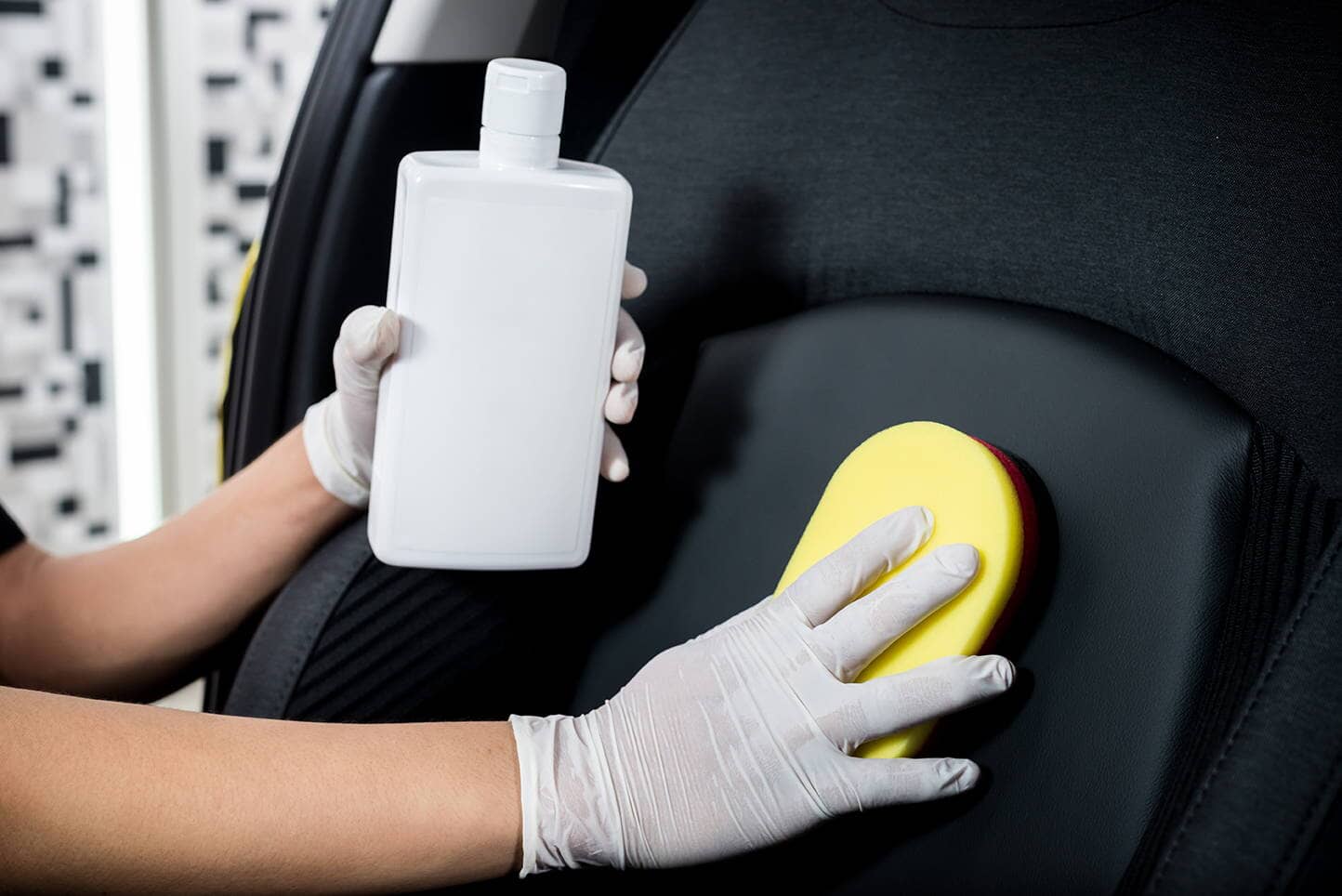When kept clean and conditioned, your leather car seats look good, smell just as nice, and feel as soft as butter.
However, they require the right touch when cleaning to avoid damaging the material and leaving them in a sad state.
To learn how to best clean and maintain the leather, this pro detailer guide will lay down everything you need to know.
“I’ve tried a lot of other leather cleaners and conditioners, they don’t compare. Torque Leather Restore is a night and day difference. It gave my seats a low gloss shine. I did a light coat on them last night and today they’re extra soft with a nice pleasant not overpowering smell. I recommend anybody to get a bottle or two of their leather restorer.”
Car Leather Seat Cleaning Tips
Leather needs cleaning once every three months to keep the material shiny, stain-free, and protected. The main exception is if your car spends a lot of time in direct sunlight. In that case, ramp up your cleaning sessions to every two months instead.
Of course, if kids, pets, or let’s face it, your own habits leave your seats dirty more often than not, they’ll obviously need even more attention. No matter what cleaning schedule you follow, use the following tips to get the best results.
Avoid Leather-Damaging Chemicals
If you want your seats to remain soft, supple, and attractive to the eye, it’s important to avoid chemicals known to damage leather, such as:
- Acetone
- Alcohol
- Petroleum
Also, skip the abrasives, including mild ones like baking soda, since these can mar the surface and dull the color. Harsh chemicals are even worse to use, as they quickly cause the surface to grow brittle and crack apart.
So, when picking out your leather cleaning products, carefully scour the labels for any of these offending substances. Alternatively, you could go the DIY cleaner route to make sure you know exactly what’s in your mix.
Make Note of Holes, Deep Tears, And Perforated Material In Leather Upholstery
Before you wipe down the seats, take a close look for holes, deep tears, and perforated surfaces. If you note any holes or tears, plan to avoid them to keep the cleaning liquid from getting inside. Otherwise, it could damage the inner foam and leave your seats less than cushy in no time flat.
If your seats have any perforated surfaces, you’ll just need to use much less cleaning solution on those areas. Make sure your rag isn’t doused in cleaning liquid, or it could fill up those tiny holes and leave behind lots of residues.
Spray The Cleaning Solution On A Cloth First Instead Of The Seat
Whether you’re working with perforated or solid leather seats, always spray the cleaning solution directly on the cloth. If you spray the cleaner all over the seats, it could drip down into the crevices. The extra exposure time isn’t good for the leather, either, even when using gentle cleaning products.
Use Soft Bristle Brushes When Cleaning Leather Car Seats
When a cloth just won’t do to clean up the dirty areas, you’ll need a soft-bristle brush to get the job done. With the soft bristles, you can work in a light circular motion to lift dirt and grime without damaging the seats. Anything more robust will scratch the surface and leave your seats looking worn.
To find the softest possible brushes, look for ones made with natural horsehair bristles that are about one inch in length. Make sure the brush has a contoured handle that gives you a firm grip without tiring out your hand. You’ll need to put minimal pressure on the brush as you clean, which means it will likely take much more time to scrub away tough dirt and grime.
Although there are many such brushes on the market today, avoid brushes that attach to a drill. These are usually much too aggressive for leather car seats, especially if you accidentally push down too hard. Instead, take plenty of breaks if scrubbing tires you out, making sure to thoroughly dry the surface before walking away.
Never Let The Cleaning Products You Spray Dry While Wet
As you work, keep the cleaning products wet as you scrub and wipe the surface. You don’t want to scrub when the leather is dry, or it could leave scratches and even impact its color. So, check your cloth often and add a bit more cleaner to it as needed to keep the surface wet as you wipe away the dirt.
Use A Microfiber Towel Over Other Types
For the gentlest possible touch, always use a microfiber towel over other options, except when the job needs a soft-bristle brush. When using these towels, you can trust that the ultra-soft fibers are never abrasive. Even better, they trap dirt deep inside them to keep it from scratching the surface as you work.
Never use shop rags or paper towels on leather car seats, as these are highly abrasive. Although they feel somewhat soft to the touch, their tough fibers will leave scratches and discolor the material.
How To Clean Leather Car Seats
When it comes time to get your leather car seats as clean as a whistle, you’ll need to select the perfect products and follow all the right steps to achieve your desired results. Here’s what you need to know to get started.
Option A: Picking Out A High-Quality Leather Conditioner
For a hassle-free experience and true peace of mind, simply pick out a high-quality leather conditioner such as Torque Leather Restore. Designed to nourish, revive, and protect, this conditioner truly does it all to leave your leather looking great through the years.
Beyond gentle cleansers, it contains vitamin E to nourish the material, keeping it soft and supple. It also includes UV protection that shields the leather from the sun’s damaging rays even through the summer season. As an added benefit, the conditioner is ready to spray onto the cloth and also works on vinyl, rubber, and plastic trim.
Option B: Making A Natural Non-Toxic Leather Cleaner
If you want to try your hand at making a natural non-toxic leather cleaner, you will need:
- ¼ cup olive oil
- ¼ cup white vinegar
- ¼ cup water
Pour all the ingredients in a spray bottle and shake vigorously to combine everything together. You’ll need to use the cleaner right away or the oil and vinegar will separate as it sits. If that happens, just give it another good shake before spraying the mixture onto your cloth.
This option is low cost and works in a pinch when you need to quickly clean your leather seats. The downside is that it doesn’t protect the seats from UV rays, nor does it contain any vitamin E to keep the material soft and flexible.
You Need Shine and . We've Got You Covered.
Ceramic Spray by Torque Detail
My car is slick as glass!! I put the Ceramic Spray on my Corvette Stingray and it is very slick and shiny. I should have purchased it sooner." - Charlie F.
Option C: Other DIY Home Remedies For Cleaning Leather
If you don’t have a commercial leather cleaner or the right natural ingredients on hand for a DIY recipe, there are a few home remedies you can try, such as:
- Facial cleanser
- Baby shampoo
- Dish soap
- Lemon juice
Just select the one you like best and dilute it in water to create a mild cleanser. Consider wiping down your seats with a plain damp rag afterward to remove any residue and shine up the surface. However, as with the DIY recipe, these remedies don’t have any of the protective qualities found in pre-made leather conditioners.
The Steps
Once you’re ready to start cleaning your seats, put your car in a shady area and grab all your supplies, including:
- Your leather cleaner of choice
- Microfiber rags
- Soft-bristle brush
- Shop vacuum
By having all the items already nearby, you can keep the cleaner from drying on the surface and breeze through the following steps with ease.
Vacuuming And Removing Surface Dirt
Tiny pieces of grit can wreak havoc on leather if left in place while you attempt to scrub them clean. For that reason, every cleaning session needs to start with a thorough vacuum job. Select your attachments carefully to make sure you can get into all the nooks and crannies while you work. Gently press around the seams and run the vacuum along those areas to get every last bit of dirt off the surface.
Once you’re done vacuuming, take a clean, dry microfiber rag and wipe off all seat surfaces while watching closely for pockets of dirt. If you notice any areas missed by the vacuum, pull it back out and suck up the grit to keep it from scratching your seats.
Spot Testing
No matter what type of leather cleaner and conditioner you choose, it’s vital that you spot test before covering the seats in that substance. To spot test, choose a hidden area on the leather, such as near the base of the seat next to the center console. Just make sure you can inspect the area for defects even though it’s out of the way.
Once you select a spot to test, put a dot of cleanser on your rag and rub it on no more than a one-inch area, making sure to remove all the excess residue. Then, let it sit for about 15 minutes before coming back to take a look. If the leather looks discolored or feels rough to the touch, don’t use that cleanser on the rest of the seats. Instead, select something else and try another spot test in a different hidden area.
Buffing
After finding a cleaner that passes the spot test, you can move on to the most time-consuming part of the process: buffing the seats clean. Plan to work from top to bottom and only spray the cleaner on the rag, not the seats. Don’t saturate the microfiber cloth with cleaner, either. Only apply enough so that the rag feels lightly damp, especially when working around areas with perforations, tears, or holes.
If the cleaner-covered cloth cannot remove dirt and grime, switch to a soft-bristle brush. Apply the cleaner to its bristles and scrub in a circular motion while using the lightest touch possible. Even though the bristles are soft and flexible, you should never press down hard while cleaning your seats. Go back over the deep cleaned areas with a microfiber rag to remove any excess cleaner.
As you work, don’t forget to tilt the seat back and wipe around all its crevices. Also remember to wipe down along both sides of the seat, including next to the seatbelts.
Drying
Once your leather car seats are nice and clean, you can let them air dry as long as you’ve wiped away all the excess cleaner. Just make sure your car isn’t sitting in a sunny area during this process. Otherwise, the moisture could magnify the sun’s rays, causing the color to fade and making the material feel brittle.
How To Remove Stains From Leather Car Seats
If your leather car seats have stains, you’ll need to go well beyond the normal cleaning process to either lift the offending substances or blend in the discolorations.
Water Stains
Water stains create a dark outline on the leather that doesn’t come out with normal cleaning. Instead, you have to use a damp cloth to blend in the edges and reduce the appearance of the stain. Make sure the water is room temperature and rub as gently as possible to get the entire affected area evenly wet. Then, let it dry fully before cleaning the area with a high-quality leather conditioner. You may need to repeat this process several times to fully remove the water stain.
Grease Stains
If grease gets on the leather, it will leave an oily blotch that muddies the seat’s natural mottled color. To remove this problematic substance, you must first blot up as much of the grease as possible using a soft cloth. Then, you can sprinkle cornstarch or unscented talcum powder over the spot to let it soak up the rest of the grease. Let it sit for at least a few hours or even overnight before vacuuming it all up and checking the spot. Repeat as many times as necessary to fully remove the grease.
Oil Stains
Oil is much like grease except that it seeps into leather much faster, especially in perforated sections. You’ll need to act fast to blot up the oil as soon as it spills to have the best chance of fully removing the stain. After that, pour a generous amount of unscented talcum powder or cornstarch over the oil stain. Allow the powder to soak up the oil overnight, then return the next day to vacuum it all up. You may need to repeat this process multiple times before the stain starts to disappear.
Ink Stains
Ink is difficult to clean off leather since you don’t want to use rubbing alcohol or acetone on the material. Instead, you’ll need to apply a high-quality leather conditioner to a cotton swab and gently scrub the stain until it disappears. Don’t scrub outside the stain or you could spread the ink to other parts of the seat. Replace the cotton swabs as they pick up the ink to fully remove the pigment a little at a time.
Tips For Maintaining Leather Car Seats Over Time (Keeping Them In Good Condition)
As long as you use the right cleaning products and steps on a regular schedule, you can keep your leather in great condition for years to come. A high-quality leather conditioner can help immensely, since it protects the seats from UV rays and has vitamins that keep the material smooth and supple.
If you can’t commit to using conditioning products, park your car in the shade as much as possible to protect it from the sun. Alternatively, you can place a car cover over your vehicle whenever it’s parked to minimize its exposure to UV rays.
Other ways to keep the leather in good shape include:
- Avoiding wearing sharp belts or other accessories in the car
- Keeping pets off your seats or at least putting a blanket down first
- Never eating food or drinking beverages in your vehicle
- Cleaning up all spills right when they happen
- Using protective covers when maintaining your vehicle
Through all your efforts, you will be well-rewarded by leather car seats that maintain their soft feel and gorgeous appearance. Your car will not only look, smell, and feel its best, but also retain its resale value over the years.
Are you telling me those seats aren't brand new?
Leather Restore Brings Old Leather Back to Life!
"Applying the product was simple and easy. The results was superb. Once the job was done, riding in the vehicle was like the first day when I bought it" - Dean C.







